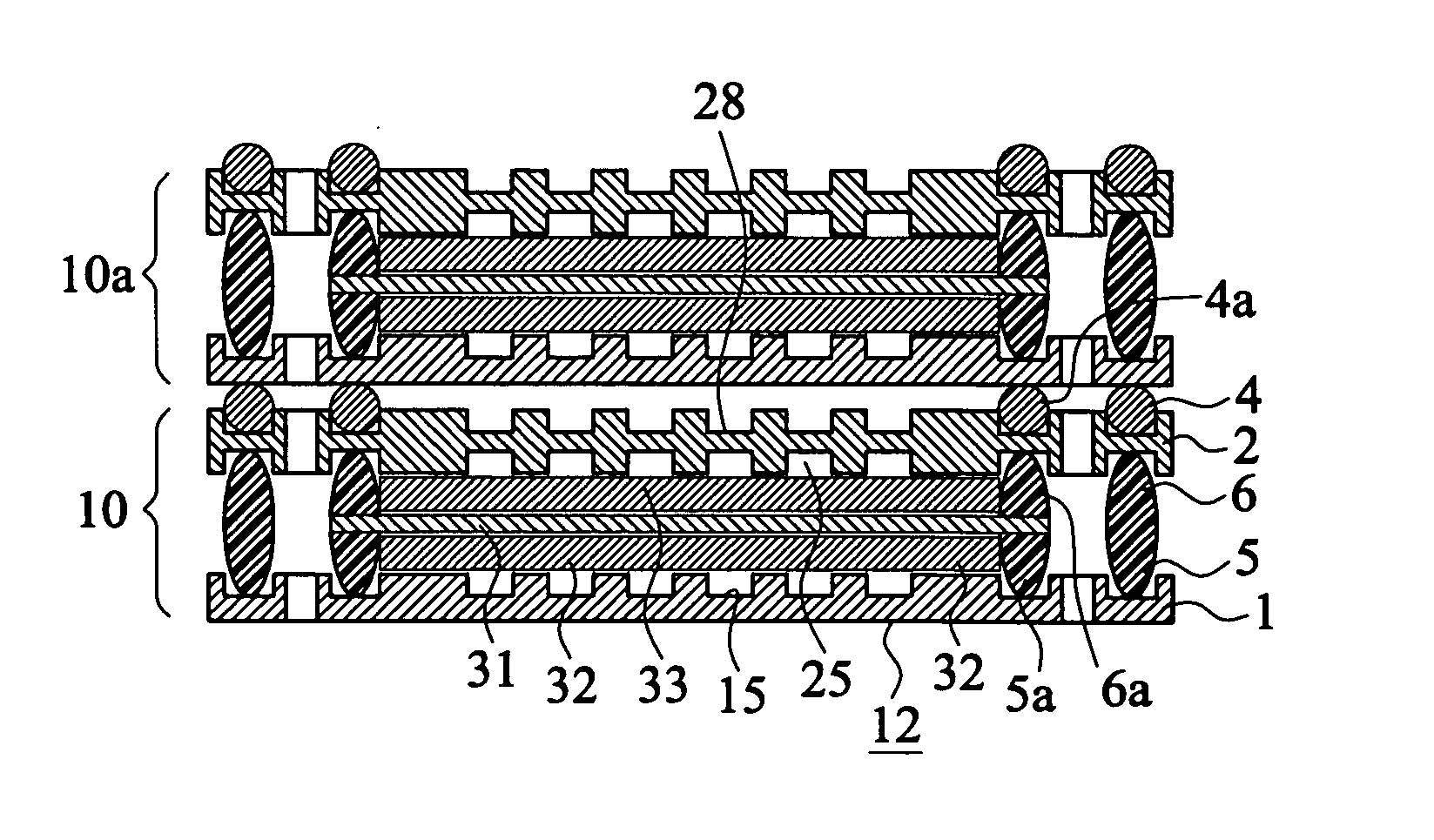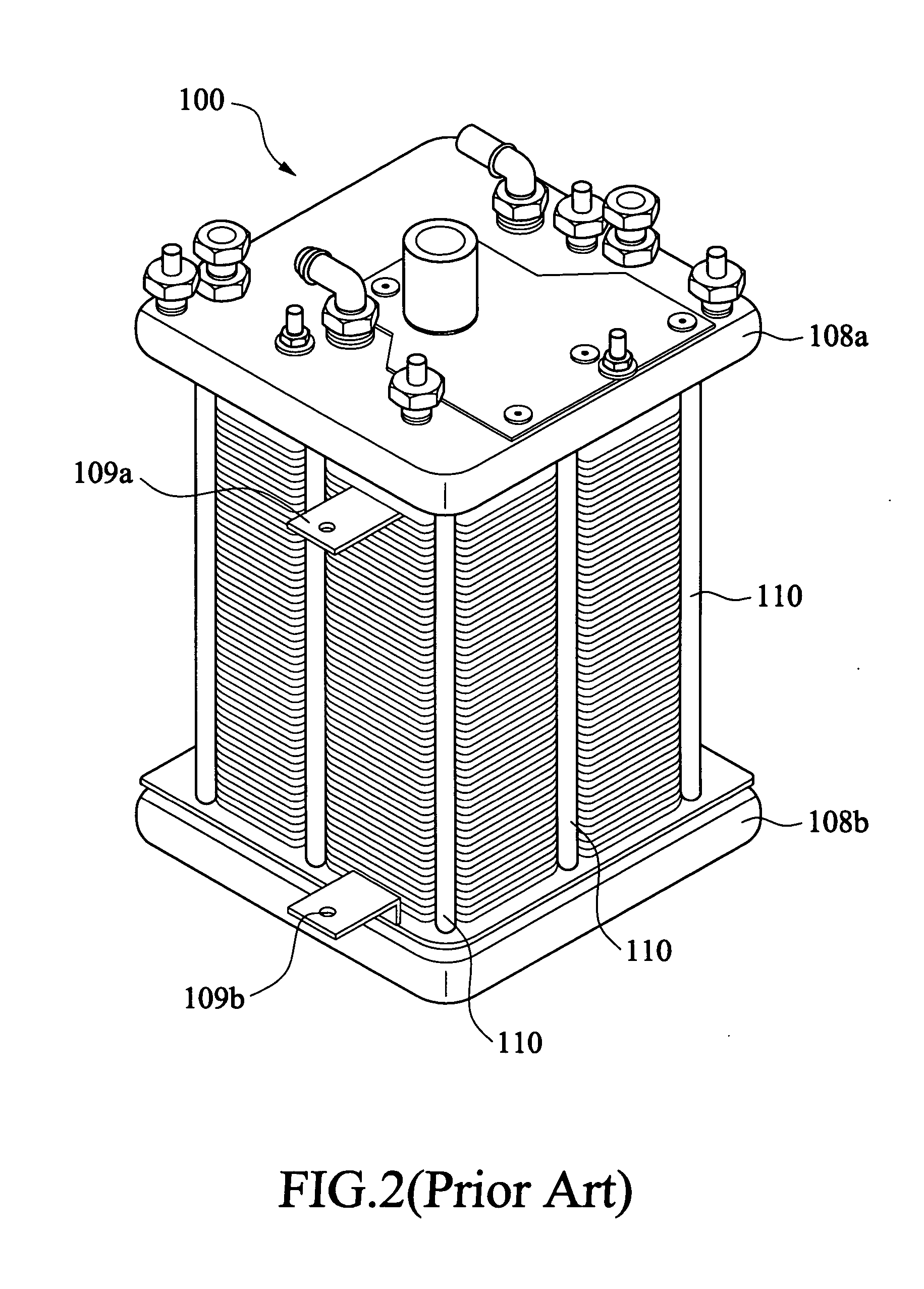Sealing structure for sealing separator plates of fuel cell modules
a fuel cell and separator plate technology, applied in the direction of cell components, cell component details, electrochemical generators, etc., can solve the problems of insufficient quality, inability to meet, and precise control, and achieve the effect of reducing manufacturing costs, simplifying the manufacturing process of pemfc, and improving the quality of the whole fuel cell
- Summary
- Abstract
- Description
- Claims
- Application Information
AI Technical Summary
Benefits of technology
Problems solved by technology
Method used
Image
Examples
second embodiment
[0045]FIG. 6a shows a cross-sectional view of the present invention, in which two single cells are superimposed to form a fuel cell module. Two modulized single cells 10, 10a are formed in accordance with the technology as mentioned. Please refer to FIG. 6B. The single cells 10, 10a are then stacked together, such that the anode plate 1 at the bottom of the second single cell 10a is superimposed on the top of the cathode plate 2 of the first single cell 10. Accordingly, the plane structure of the second surface of the anode plate of the second single cell 10a forms the top surface of the coolant channels on the first surface 21 of the cathode plate 2, providing a passage for coolant flowing therethrough. By means of the silicon rubbers 4, 4a which are previously applied at the first surface 21 of the cathode plate 2 of the first single cell 10 and by compressing the two modulized single cells 10, 10a with a predetermined compression pressure, the two single cells 10, 10a are stably ...
third embodiment
[0046]FIG. 7A is a cross-sectional view showing the cell module constructed in accordance with the present invention. In the example shown, the cell module comprises two MEAs, one bipolar plate, an anode plate and a cathode plate. Similar reference numerals are used to identify elements that are similar or identical as that in FIGS. 5A to 5D.
[0047] In this embodiment, the cell module 10b comprises an anode plate 1, a bipolar plate 7 and a first MEA 3a. The anode plate 1 has a first surface 11, a second surface 12, a central portion 13, a circumferential portion 14, a plurality of anode gas channels 15, a peripheral groove 17, an extended groove 17a, and a plurality of ports. The bipolar plate 7 comprises a first surface 71, a second surface 72, a central portion 73, a peripheral portion 74, a plurality of cathode gas channels 75, a peripheral groove 77, an extended groove 77a, a peripheral groove 79, an extended groove 79a, and a plurality of ports. Furthermore, the first surface 71...
fourth embodiment
[0052]FIGS. 8A to 8B are cross-sectional views showing the stacking of two cell modules of FIG. 7D to form a fuel cell stack in accordance with the present invention. In assembly, two cell modules 10b, 10c manufactured by the technology are stacked together in series, such that the second surface of the anode plate of the cell module 10c is superimposed on the first surface of the cathode plate of cell module 10b, as shown in FIG. 8b. Accordingly, the flat structure of the second surface of the anode plate of cell module 10c forms the top surface of the coolant channels on the first surface of the cathode plate 8. By means of the silicon rubbers 91, 91a applied at the first surface of the cathode plate 8 of the cell module 10b, and by compressing the two cell modules 10b, 10c with a predetermined compression pressure, the two cell modules are bound together, forming a tight structure. Hence, the coolant channels are tightly sealed for flowing of coolant therethrough.
PUM
| Property | Measurement | Unit |
|---|---|---|
| temperature | aaaaa | aaaaa |
| temperature | aaaaa | aaaaa |
| dielectric strength | aaaaa | aaaaa |
Abstract
Description
Claims
Application Information
 Login to View More
Login to View More - R&D
- Intellectual Property
- Life Sciences
- Materials
- Tech Scout
- Unparalleled Data Quality
- Higher Quality Content
- 60% Fewer Hallucinations
Browse by: Latest US Patents, China's latest patents, Technical Efficacy Thesaurus, Application Domain, Technology Topic, Popular Technical Reports.
© 2025 PatSnap. All rights reserved.Legal|Privacy policy|Modern Slavery Act Transparency Statement|Sitemap|About US| Contact US: help@patsnap.com



